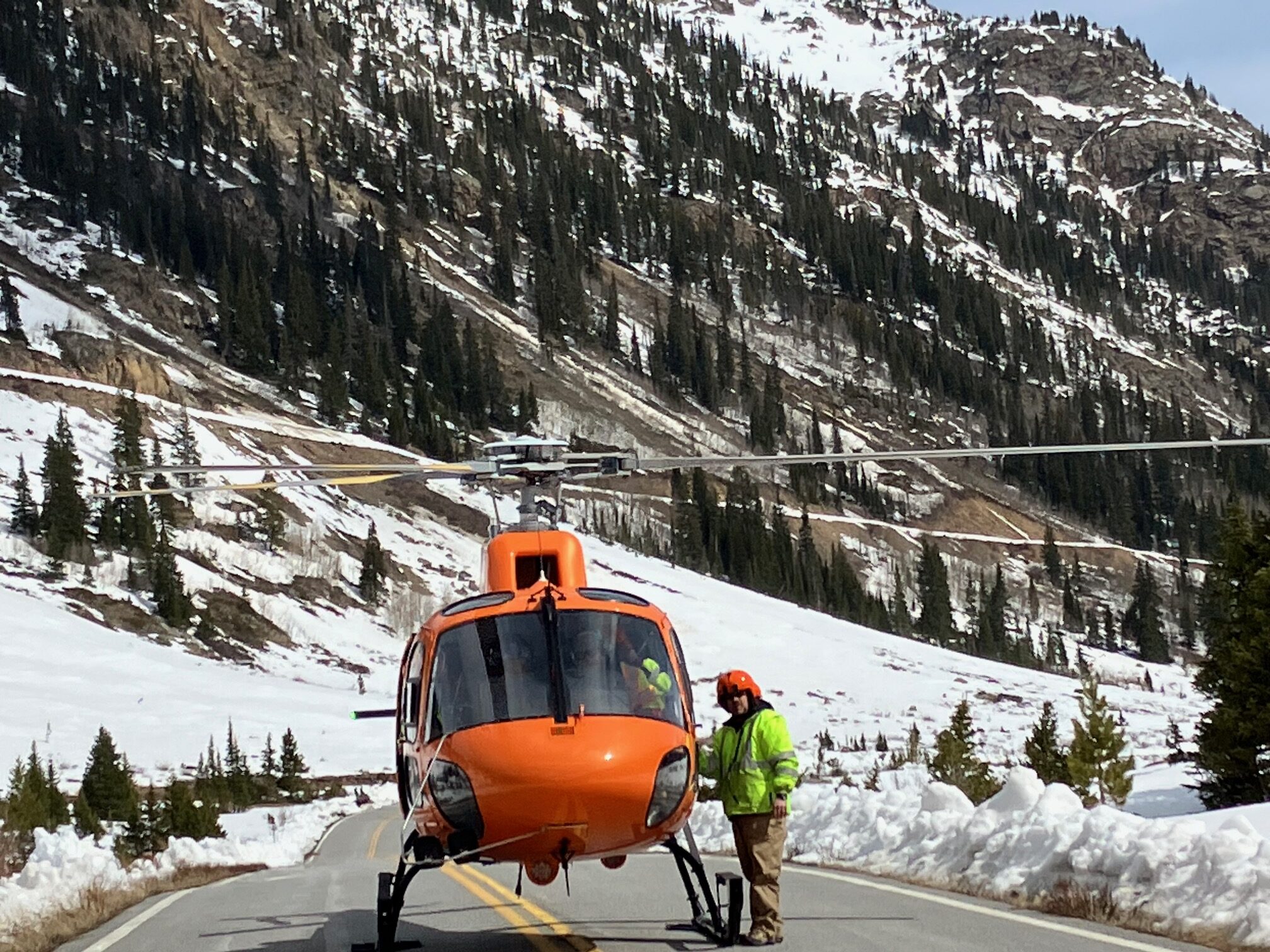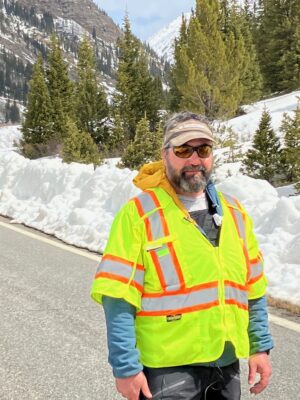
The helicopter loaded with explosive devices gets final drop instructions, prior to beginning another bombing run to remove snow from dangerous slide areas above U.S. 82; the road over Independence Pass. Photo by Jan Wondra.
This time of year, there are still many feet of snow on U.S. 82 over Independence Pass. There’s a time crunch; the Colorado Department of Transportation (CDOT) has to clear it down to the pavement by Memorial Day weekend so that the road between Twin Lakes and Aspen – arguably the most scenic road in America — is open for tourists.
This past week Ark Valley Voice was among the Colorado news media invited to witness the clearing operations. We got not just a lesson on snow removal, but in road safety. Our teachers: the tight collaboration between CDOT and the Colorado Avalanche Information Center. The two entities work in lock-step to make the roads and byways of the Colorado Rockies safe for us to enjoy — and show off to our visiting families and friends.

Ethan Greene, of the Colorado Avalanche Information Center explains their collaboration with CDOT. Photo by Jan Wondra.
“It is exciting, we invited you here to really see what we do, to see avalanches close enough to see the natural phenomena,” said Colorado Avalanche Information Center Director Ethan Greene.
“This particular area hasn’t had as much snow as in other parts of the state where we’ve had more snow than we’ve ever had,” said Greene. “This route is not open all year around, and a lot of things have to line up to do this work — the personnel, the helicopter, the weather to cooperate … it’s a difficult task. We’ll see 20 to 30 avalanches today.”
It might be springtime in the valleys, but the snow still lies deep and heavy on the roadbed of U.S.82 over Independence Pass, which has been closed all winter. It would be one thing for CDOT to clear this blacktop two-lane road of the five to six feet of seasonal snow on the roadbed. It’s another task entirely to make that road safe for travelers.
That’s because on the high peaks above that roadway – one of the highest in the U.S. — lies 20 feet, 30 feet, or more of the deep, wet, white stuff. That snow has drifted in overhanging cornices far out past the ridges to which it clings. It’s beautiful to look at. It’s deadly if it were to fall.
Unless removed, those snow cornices threaten to give way and begin the slide downward. As the avalanche begins. it is nearly imperceptible. But as it gathers speed, it widens, it deepens, it accumulates rocks and dirt and trees, and turns a menacing dirty brown as it rolls downslope. When it lands on the roadway hundreds of feet below where it began, it is 35 feet deep on the road.

The helicopter hovers over a cornice area overhanging CR 82 in an area known as Bueller Road, preparing to drop turkey bombs above a slide area. Photo by Jan Wondra.
Planning and creating a controlled avalanche is much preferable to it burying a line of cars headed over the pass, which is why the Colorado Avalanche Information Center is working that day with CDOT using explosives to create several controlled avalanches to remove the threat.
We came for a closeup view of how U.S. 82 gets unburied after a winter of record snows and got a better understanding of just how the collaboration works. The work is coordinated with specialty teams of from five to eight, including two CDOT avalanche experts, and a Colorado Avalanche Information Center expert, with a contract helicopter. There are different contractors for different parts of the state.
As the helicopter roared overhead, a few dozen employees of the Colorado Department of Transportation (CDOT) and the Colorado Avalanche Information Center prepared for dropping the explosives — called turkey bombs, which looked like large turkeys wrapped in aluminum foil. They had already dropped about a dozen before the media arrived, and by mission end, they had dropped 42 charges.
“This sound never gets old. It’s exciting every time. We’re out here using explosives to mitigate Mother Nature in the name of public safety and worker safety,” said CDOT Avalanche coordinator Brian Gorsage. “We’re using lots of turkey bombs instead of howitzers. They’re about 8.6 pounds and we’re putting in from 22 to 30 pounds of explosives per shot here today… they are super powerful. We figure, if we’re going to pull out all the shots to do this we’re going to hit this slope and get it done.”
“Part of this is mapping. We know specific places where avalanches happen,” said Greene. “We forecast the danger all winter long. We look at times when the avalanche threat is getting too high – we talk to CDOT and shut the road down … they get it ready for the traveling public.”

Clearing CR 82 over Independence Pass takes the collaboration of dozens of people from CDOT and the CAIC. Photo by Jan Wondra.
Greene explained that Independence Pass is a bit different than other Colorado mountain roads. “This has been closed all year. Up above us we still have the seasonal snow cover that is sitting on the road. We identified this week as a good time we could come in and be able to knock some snow and get it down to the valley floor. We’re using a helicopter and they are using charges in areas where we feel we’ll have the best result. As that snow moves down the hill… hopefully it moves below the road to reduce the threat. Then when we’re done, CDOT crews will go in and work their way up the pass.”
Green explained that the grade we were viewing (in the attached photos and avalanche video) is called the Bueller Road, and the road runs through the track of the slide area. The overhanging mass of the cornice he pointed out, might not fall on a moderate day like the one when we visited. “It might not be as big a deal now, but in spring at some point, it’s going to calve off and head downhill,” Greene explained. “What we’re trying to do is get in there and not have to worry about it.”
As many of us who live in the mountains know, CDOT spends a lot of time managing avalanche risks. This type of work is being done all winter long on areas such as Monarch Pass, where there are long-time slide areas. CDOT explained that even when a slide starts slowly, it widens and gathers speed and weight as it moves, often becoming a really big flow, including debris. The slide above ended up on the roadway below and CDOT representatives estimated it brought down about 20 feet of debris on the roadway– a depth taller than one of their pieces of heavy machinery.
When asked whether CDOT would consider keeping Independence Pass open all winter, Greene chuckled and said “That’s a complicated question, this is not the only threat on this road. A lot of avalanche paths threaten this highway – — this is the most dangerous highway in the state. Keeping it open in the winter would involve a lot of different things … it would be possible, but it would be very expensive. Transportation managers have to balance risk and expense.”
“This is the first mitigation effort here for the season, and hopefully the last,” said Gorsage. “We’re giving ourselves a 30-day buffer – Mother Nature will dictate it — weather and cooling come into play. This pass is super important, the other mountain passes we mitigate throughout the year, this one, no.”
The marriage of CAIC and CDOT began in 1992, sometime after a road crew clearing snow in the southwestern portion of the state on U.S. 550 was swept over the edge in a massive snow slide. CDOT hasn’t had an avalanche death since then. The arrangement is cemented with an IGA (intergovernmental agreement). “We pay them to do the weather and the forecasting, they make recommendations to do the mitigation work,” explained Gorsage. “Our maintenance crews communicate daily, and multiple times a day during the storms”.
The crews are working hard, and after snow removal, there is also winter maintenance of the road. “We want to reduce the snow volume in this area, trying to get the mass down,” explained Gorsage. “Trail Ridge Road is high, but it’s not got avalanche passes and its National Park Service. Frankly, the weather dictates all we do right now.”
The goal? Get U.S. 82 open by Memorial Day weekend.







Recent Comments